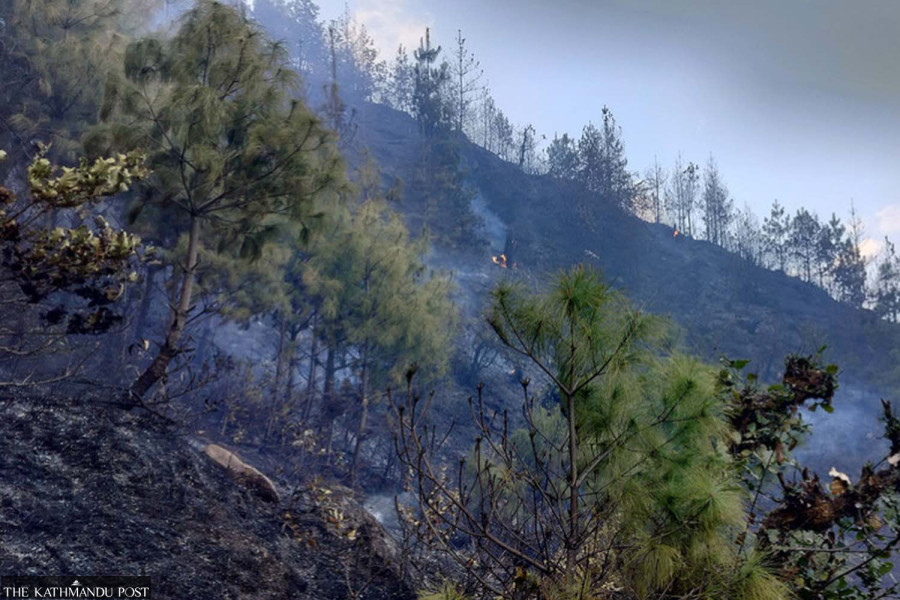Editorial
Ignored infernos
Although wildfires have been growing at a troubling rate, they remain a low priority.
Fires have begun to devour Nepal’s forests again. Three months into the year, countless forest fires have devastated hectares of biodiversity-rich land across the country. An extended winter drought has caused an early onset of the wildfire season. At least 76 incidents of fire were reported in a single week in January. In February, a forest fire ravaged approximately 82 hectares of forest, primarily in the upper regions of Jugal and Bhotekoshi rural municipalities, while another burned Timang's forest in the mountain district of Manang for days. Last year, over 5,125 forest fires were documented nationwide from January 1 to June 24, affecting 74 of the country’s 77 districts. Although wildfires have been growing at a troubling rate and reversing years of conservation efforts, they remain a low priority for authorities.
These large-scale, recurring forest fires have resulted in environmental damage over the years. A recent research indicates Nepal’s forest fires could release over 170 million tonnes of soil organic carbon and 325 million tonnes of above-ground wood carbon. The decades-long efforts to restore Nepal’s forests and improve the environment now ironically contribute to its rapid degradation. This is evident in the degrading air quality of many regions of the country and the health consequences people face.
According to experts, wildfire risk in Nepal’s south has been rising since 2001 and six of Nepal’s 20 protected areas, including Chitwan and Bardiya National Parks, are under extreme threat. The destruction of these scenic areas is hampering tourism, the backbone of our economy. Apart from the commercial implications, biodiversity loss affects the livelihoods of communities that depend on forests and the wildlife whose habitats are being destroyed.
Although wildfires can be natural, we cannot attribute these extreme cases solely to nature. In Nepal, human activities like discarding unextinguished cigarette butts, burning dry vegetation to clear land for farming, and intentional fires set by grazers and poachers are frequent causes of forest fires. Besides climate change, large-scale migration of people from rural mountain regions has reduced the collection of fuel and fodder, allowing highly combustible dried biomass to accumulate, increasing the risk of fires. This also means few people are available to quickly manage local fires in the nearby forests of rural areas.
In 2010, Nepal’s Ministry of Forests launched the Forest Fire Management Strategy, but it has largely been ineffective. According to the Forest Act 2019, those responsible for forest fires outside protected areas face imprisonment for up to three years, a fine of Rs60,000, or both. However, these measures will remain unenforced as long as the authorities continue to remain apathetic about the issue. Additionally, the National Disaster Risk Reduction and Management Authority seems more focused on keeping records of forest fires than on addressing them. The budget for wildfire management is also limited, with most of it used for buying firefighting equipment and funding awareness campaigns.
Restoring the country’s forests took us over six decades, and their health is directly connected to the nation’s well-being. To better handle forest fires, authorities need to invest in up-to-date equipment and early warning systems and build artificial ponds in wildfire risk regions. Given that women, the elderly, and children are frequently the ones left in rural areas due to outmigration, they must get proper training to keep themselves safe and, if possible, the forests. There is not much time to lose.




 6.12°C Kathmandu
6.12°C Kathmandu












%20(1).jpg&w=300&height=200)

